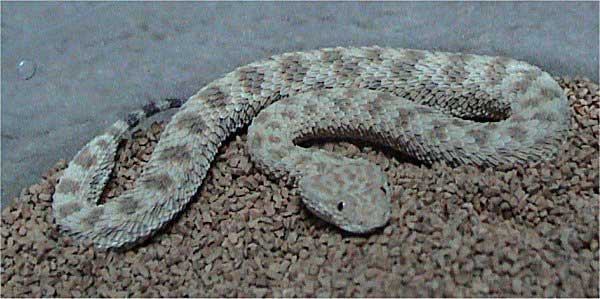
Cerastes vipera (*)
Superregnum: Eukaryota
Regnum: Animalia
Subregnum: Eumetazoa
Cladus: Bilateria
Cladus: Nephrozoa
Superphylum: Deuterostomia
Phylum: Chordata
Cladus: Craniata
Subphylum: Vertebrata
Infraphylum: Gnathostomata
Superclassis: Tetrapoda
Cladus: Reptiliomorpha
Cladus: Amniota
Classis: Reptilia
Cladus: Eureptilia
Cladus: Romeriida
Subclassis: Diapsida
Cladus: Sauria
Infraclassis: Lepidosauromorpha
Superordo: Lepidosauria
Ordo: Squamata
Subordo: Serpentes
Infraordo: Caenophidia
Superfamilia: Viperoidea
Familia: Viperidae
Subfamilia: Viperinae
Genus: Cerastes
Species:Cerastes vipera
Name
Cerastes vipera (Linnaeus, 1758)
Original combination: Coluber vipera
References
Linnaeus, C. 1758. Systema Naturae per regna tria naturæ, secundum classes, ordines, genera, species, cum characteribus, differentiis, synonymis, locis, Tomus I. Editio decima, reformata. Holmiæ: impensis direct. Laurentii Salvii. i–ii, 1–824 pp DOI: 10.5962/bhl.title.542: 216. Reference page.
Vernacular names
Deutsch: Avicennaviper
English: Sahara Sand Viper
українська: Гадюка Авіцени
中文: 撒哈拉角蝰
Cerastes vipera, common names Sahara sand viper and Avicenna viper,[3] is a venomous viper species endemic to the deserts of North Africa and the Sinai Peninsula. No subspecies are currently recognized.[4]
Description
C. vipera, neonate.
Adults average 20–35 cm (8-14 inches) in total length (body + tail), with a maximum total length of 50 cm (1.6 ft). Females are larger than males.[3] Small and stout, it has a broad, triangular head with small eyes set well forward and situated on the junction of the side and the top of the head.
Their hunting strategy is unique when compared to that of other viperids because they use a combination of both sit-and-wait ambushing and active hunting. Active hunting is predominantly used in the months right before hibernation to increase energy intake before the long dormant period.[5]
Common names
Common names include Sahara sand viper, Avicenna viper,[3] common sand viper,[6] Egyptian asp, Cleopatra's asp, sand viper,[7] Avicenna's sand viper, lesser cerastes.[8]
Geographic range
It is found in arid North Africa: Mauritania, Morocco, Algeria, Mali, Tunisia, Libya, Niger, Chad and Egypt. Sinai Peninsula: Egypt,[9] Sudan and Israel.
The type locality given is "Ægypto" (Egypt).[2]
References
Wilms, T.; Wagner, P.; Joger, U.; Geniez, P.; Crochet, P.-A.; El Mouden, E.H.; Mateo, J.A. (2013). "Cerastes vipera". IUCN Red List of Threatened Species. 2013: e.T178210A15636436. doi:10.2305/IUCN.UK.2013-1.RLTS.T178210A15636436.en. Retrieved 12 November 2021.
McDiarmid RW, Campbell JA, Touré T. 1999. Snake Species of the World: A Taxonomic and Geographic Reference, Volume 1. Herpetologists' League. 511 pp. ISBN 1-893777-00-6 (series). ISBN 1-893777-01-4 (volume).
Mallow D, Ludwig D, Nilson G. 2003. True Vipers: Natural History and Toxinology of Old World Vipers. Malabar, Florida: Krieger Publishing Company. 359 pp. ISBN 0-89464-877-2.
"Cerastes vipera". Integrated Taxonomic Information System. Retrieved 30 July 2006.
Horesh, Sefi; Sivan, Jaim; Rosenstrauch, Avi; Tesler, Itay; Degan, A; Kam, Michael (February 2017). "Seasonal biotic and abiotic factors affecting hunting strategy in free-living Saharan sand vipers, Cerastes vipera". Behavioural Processes. 135: 40–44. doi:10.1016/j.beproc.2016.11.013. PMID 27899311.
Gotch AF. 1986. Reptiles — Their Latin Names Explained. Poole, UK: Blandford Press. 176 pp. ISBN 0-7137-1704-1.
Brown JH. 1973. Toxicology and Pharmacology of Venoms from Poisonous Snakes. Springfield, Illinois: Charles C. Thomas. 184 pp. LCCCN 73-229. ISBN 0-398-02808-7.
U.S. Navy. 1991. Poisonous Snakes of the World. United States Government Publication. New York: Dover Publications Inc. 203 pp. ISBN 0-486-26629-X.
Abukashawa, S.M.A., Papenfuss, T.J. & Alkhedir, I.S. 2018. Geographic Distribution: Cerastes vipera (Sahara Sand Viper). Herpetological Review 49 (1): 75.
Further reading
Boulenger GA. 1896. Catalogue of the Snakes in the British Museum (Natural History). Volume III., Containing the...Viperidæ. London: Trustees of the British Museum (Natural History). (Taylor and Francis, printers). xiv + 727 pp. + Plates I.- XXV. (Cerastes vipera, pp. 503–504).
Joger, Uhlrich. 1984. The Venomous Snakes of the Near and Middle East. Beihefte zum Tübinger Atlas des Vorderen Orients, A, 12. Wiesbaden: Dr. Ludwig Reichert Verlag. 115 pp. ISBN 3882261994.
Linnaeus C. 1758. Systema naturæ per regna tria naturæ, secundum classes, ordines, genera, species, cum characteribus, diferentiis, synonymis, locis. Tomus I. Editio Decima, Reformata. Stockholm: L. Salvius. 824 pp. (Coluber vipera, p. 216).
Schnurrenberger, Hans. 1959. Observations on Behavior in Two Libyan Species of Viperine Snakes. Herpetologica 15 (2): 70-72. (Aspis vipera).
Subach, A, Scharf, I & Ovadia, O. 2009. Foraging behavior and predation success of the sand viper (Cerastes vipera). Canadian Journal of Zoology 87: 520-528. PDF
Retrieved from "http://en.wikipedia.org/"
All text is available under the terms of the GNU Free Documentation License

